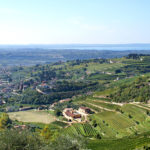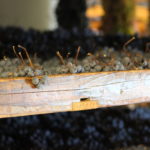Valpolicella: Territory, Tradition & Timeless Hospitality
Nestled between Lake Garda and the city of Verona, Valpolicella is one of Italy’s most iconic wine regions — a land of gently rolling hills, historic villas, and terraced vineyards. Its name, believed to mean “valley of many cellars,” reflects a long-standing winemaking heritage dating back to Roman times.

La Collina dei Ciliegi www.lacollinadeiciliegi.it
This young wine estate in the Valpantena area was founded just 15 years and has some of Valpolicella’s highest vines up to around 600m asl. The altitudes together with chalky soils contribute to the fresh elegance of the wines, which include Garganega-based whites as well as Valpolicella Superiore and Amarone. This elegance is mirrored at the winery’s Ca’ del Moro Wine Retreat and restaurant where impeccable style paired with a relaxed atmosphere make for memorable stays and delicious meals with the estate’s and other local wines. Paths through the vineyards for walkers and ebikes make it easy to enjoy the stunning Valpantena countryside, while the estate also offers horse-riding and even helicopter rides to admire the landscapes from the sky.
Wine to try: Ciliegio, Amarone della Valpolicella DOCG
Following a late-September harvest by hand, grapes are left to dry for the traditional 100 days. A period of 36 months in a combination of large and small barrels of French oak is followed by eight months of bottle ageing for a smooth, chocolatey wine with ripe dark fruit aromas.
Tedeschi www.tedeschiwines.com
The Tedeschi siblings Riccardo, Sabrina and Antonietta, whose grandfather made wine for guests at his osteria, are among the 13 historic Amarone producers of the Famiglie Storiche association. They are Amarone specialists, making five different versions including three crus: Monte Olmi, Maternigo and La Fabriseria. While each plot brings unique characteristics to the respective wines they all share a trademark elegance. The family has also carried out pioneering in-depth studies into soil and aromaticity with Verona university. The landscapes are beautiful and tour options include vineyard visits and tasting among the vines. With the Fabriseria tour you even stroll to see the village of San Giorgio della Valpolicella and its panoramic terrace.
Wine to try: Capitel Monte Olmi, Amarone della Valpolicella DOCG Classico Riserva
Tedeschi’s historic cru, first made in 1964, from a 2.5ha plot in the Classico area. The blend incorporates Corvina, Corvinone and Rondinella grapes in equal proportions which are fermented following four months of appassimento. The result is an intense, memorable Amarone Riserva with fresh fruit and balsamic aromas.
Massimago www.massimago.com
This organic winery, run by Camilla Rossi Chauvenet whose family have owned the estate since 1883, lies in a peaceful spot in the Valle di Mezzane, east of Verona. It’s a lovely place to stay with simple yet attractive farmhouse-style bedrooms, a pool, charming garden and a small restaurant that makes good use of estate produce and local ingredients including truffles and Monte Veronese cheese as well as Massimago’s own olive oil. The winery is among the group of youthful Valle di Mezzane estates and has a fresh cheerful outlook, also aiming to reduce the heavy, serious atmosphere that has sometimes surrounded Amarone and other wines.
Wine to try: Profasio, Valpolicella Superiore DOC
An intense and age-worthy version of Valpolicella Superiore, with a smooth velvety character of cherry and berry fruit interwoven with sweet and savoury herbs, spices and balsamic aromas. Prolonged maceration with frequent pumping over brings a rich ruby colour and the wine ages two years in wood.
Serego Alighieri www.seregoalighieri.it
This winery at Gargagnago has an extraordinary history. Bought in 1353 by Pietro, son of Dante Alighieri and still run by his descendents today, it’s Valpolicella’s longest-established winery. Pietro came to the area when Dante was living in Verona, writing and studying at the Biblioteca Capitolare, the world’s longest running working library. The Serego Alighieri wines spend six months in cherry wood barrels following the historic local tradition – cherries are typical here. There are also eight country-style b&b apartments, cookery classes are held and the charming courtyard has a pre-phylloxera vine. The winery is part of the Masi group whose main estate is a short stroll away through the vines.
Wine to try: Vaio Armaron, Amarone della Valpolicella DOCG
An intense Amarone made with Corvina, Rondinella and Serego Alighieri’s own clone of Molinella grapes. Characteristics include integrated tannins, spicy notes and aromas of plum and cocoa leading to a finish that brings out hints of cherry thanks to the wood used for a period of ageing.
Zýmē www.zyme.it
As a former consultant winemaker with extensive experience working with some of the area’s leading names in wine, Celestino Gaspari felt the need to spread his wings with experimentation when he first opened his winery 25 years ago. While he continues to go his own way, making such intriguing wines as Harlequin, a red blend of at least 15 different grape varieties, and he pioneered single-variety Oseleta, he now makes more traditional Valpolicella wines too. The cellar is simply stunning, housed in the sequence of underground chambers of a 15th century sandstone quarry, with ideal temperatures and humidity all year round.
Wine to try: La Mattonara, Amarone della Valpolicella Classico Riserva DOCG
An intense Amarone riserva dedicated to the historic former quarry where the wine cellar is now located and perfect with tasty cheeses, dark chocolate or grilled meats. Grapes dry naturally for around three months before fermenting with wild yeasts in concrete tanks followed by ten years ageing in large wood barrels.
Vigneti di Ettore www.vignetidiettore.it
Young winemaker Gabriele Righetti runs the small organic estate founded by his great-grandfather with enthusiasm, aiming for fresh elegance for his traditional Valpolicella wines and other bottles. The winery has several minor local varieties as their vineyards incorporate an experimental plot and research is carried out with Verona university. The 20ha of vines are in four separate locations near Negrar in the Classico zone and include the original vineyard at the family’s 300 year-old stone farmhouse home. Here they run an appealing four-room b&b agriturismo with an open-air infinity pool; breakfast, which can include home-made cherry jam and estate olive oil, is in the former grape-drying loft.
Wine to try: Valpolicella Ripasso Classico Superiore DOC
Gabriele chooses to partially dry the grapes for the first fermentation to extract more fruit aromas without compromising the fresh acidity, before the second fermentation brings the characteristic depth and complexity of Ripasso wines. The resulting wine has fragrant cherry aromas and a rich herby appeal.
Guerrieri Rizzardi www.guerrieri-rizzardi.it
This winery is run by one of Valpolicella’s historic wine-making families, who bought land in Negrar in 1649 and first bottled their wines 29 years later. The lovely Giardino di Pojega, an Italianate garden, was commissioned at the estate villa, Villa Rizzardi, in 1783 and nowadays is open to the public. The family also has estates in Soave and Bardolino where their former winery is now a public park, Borgo Bardolino, with shops and a restaurant called Munus, the same name as one of the estate’s wines, which is an intriguing blend of the resistant variety Merlot Khorus and Corvina.
Wine to try: Pojega, Valpolicella Ripasso Classico Superiore DOC
A fresh and enjoyable wine with an intense dark fruit character made with a selection of grapes including 10% Merlot in addition to the traditional Valpolicella varieties and a second fermentation after several months, on the grape skins used for the winery’s Amarone (this is the Ripasso method).
Le Guaite di Noemi https://leguaite.it
Noemi Pizzighella grew up amongst the vines and in 2015 took the reins of the estate founded by her parents in the Mezzane valley east of Verona. The fruit-forward wines reflect Noemi’s refreshing spontaneity, also thanks to the characteristics of terrains in the Valle di Mezzane which are a combination of white chalky soils that give a fresh acidity to the wines, iron-rich soils that contribute to the wines’ intense aromatic fabric and dark basaltic terrain of volcanic origin that adds complexity. Like many Valpolicella producers, the estate also makes olive oil and tours can include a visit to olive mill as well as the winery.
Wine to try: Valpolicella Superiore DOC
An intense and full bodied Valpolicella that despite a brief month-long period of appassimento and lengthy ageing, including 3-4 years in barriques and 3-4 years in the bottle, retains a fresh fruity character with spicy and savoury notes that make it very moreish.
Buglioni www.buglioni.it
The Buglioni locations have a stylish, relaxed vibe that combines contemporary design with country style. The family came from the field of apparel design and when, in the year 2000, Alfredo Buglioni and his son Mariano decided to start making wine they found they weren’t taken seriously and had trouble selling their wines to restaurants. Their solution was to sell it themselves and nowadays they run several places including the Osteria del Bugiardo wine bar in central Verona, a farmhouse restaurant in Valpolicella (San Pietro in Cariano), serving tempting seasonal dishes, and an Enoteca wine bar; they also offer accommodation both in Valpolicella and central Verona.
Wine to try: Il Lussurioso, Amarone della Valpolicella Classico DOCG
Made with grapes sourced from a single vineyard that dry for a couple of months for an enjoyable Amarone with inviting chocolate and black cherry aromas, vanilla and balsamic notes and a refreshing mineral style that makes it ideal for intriguing pairings such as raw seafood or beef tartare.
Masi www.masi.it
The Masi winery is a major player in the Valpolicella wine scene and current president Sandro Boscaini, whose ancestors founded the estate in 1772, is nicknamed Mister Amarone. While the group now has other wine estates in Italy and Argentina, the Valpolicella Classico winery, where research and experimentation is ongoing, is firmly at the heart of it all. In May 2025, a new structure, Monteleone21, adjacent to the historic cellars, was inaugurated where visitor experiences intertwine with wine production. The Tenuta Canova site near Lake Garda has a fascinating interactive wine museum and an informal farmhouse restaurant where the family’s ‘wine first’ philosophy guides menu choices.
Wine to try: Costasera, Amarone della Valpolicella Classico DOCG
The most traditional varieties of Corvina, Rondinella and Molinara are dried on the winery’s own-design bamboo trays for this beautifully harmonious Amarone characterised by warm fruit notes combined with a coffee and chocolatey sensation for a round and velvety sip.
